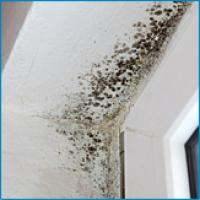
Solutions for Mold, Mildew and Musty Odors
Find Out Where YOUR Home is Losing Energy:
Problem:
You have mold, mildew or another form of biological growth in your home, which can lead to a variety of health issues, as well as rot, structural damage, premature paint failure or other damage to your home.
Mold and mildew need moisture to grow. In homes, moisture is typically caused by high humidity in the air or water leaks from inside or outside of your home. You need to get to the root of the problem to stop the mold from recurring. For more information, see the EPA's Brief Guide to Mold.
Recommendations:
Determining where the problem is occurring can help you determine the source. If the moisture damage and mold are in a confined or isolated area, it is likely by a water leak. If mold or mildew covers a whole wall or is in a larger area like an entire room, then high humidity and/or water intrusion through the building envelope may be the cause.
Mold and Mildew from Water Leaks
Water can enter your home from the outside through a leak in the roof or the foundation, or from gaps around doors and windows. Water can also leak from pipes, showers, toilets, tubs or sinks inside your home.
- If a water leak is causing your mold or mildew problem, fix the leak first to prevent the problem from happening again.
- If the leak is in the foundation, call a waterproofing contractor. If it's in your roof, call a roofing contractor. And if the leak is coming from indoors, hire a plumber to locate the leak and repair it.
- If there's substantial water damage or mold, it is a good idea to hire a certified mold remediation and water damage repair contractor. Look for a Certified Mold Inspector (CMI) or a Certified Micro Inspection and Remediation (CMRC) professional. After the leak is repaired, dry out the area and keep it dry.
Reduce Indoor Humidity to Prevent Mold and Mildew
High indoor humidity can be caused by everyday activities like cooking, showering and drying clothes. Your indoor humidity should be between 30-60%.
- Use the kitchen exhaust fan when cooking, and use the bathroom exhaust fan while bathing and for 15 minutes afterward to help control moisture levels in your home. Make sure the fans are venting to the outside, and not into the attic. Also, check the ducts for blockage, damage or disconnection.
- Seal air leaks in your home and seal air leaks in ductwork to help prevent high levels of humidity in your home. An energy assessment will show you where there are air leaks in your home and in your ductwork, as well as other energy saving opportunities.
- Your clothes dryer produces a lot of humidity, and should exhaust to the outside. Check the dryer duct to ensure that it's attached securely at both ends and free of obstructions such as lint. If your duct is damaged or has holes that leak air, replace it with a metal duct. For safety and optimal functioning, clean the duct at least once a year. Use these dryer safety tips from the US Consumer Products Safety Commission.
- Is your heating and cooling system working properly (and properly sized) to remove humidity? Have an HVAC contractor check your system to make sure.
- If you have a crawlspace with a dirt floor, cover it with a plastic vapor barrier. This will prevent moisture from evaporating from the soil and increasing the humidity in your home. Remove pools of standing water and dry any wet soil with fans before covering the floor.
Home Energy Problems & Solutions:
- Reduce High Energy Bills Energy Efficiency, Home Improvement Tools
- Drafty Rooms Air sealing, Heating and Cooling Contractor
- Peeling Paint Control moisture, Building Science Specialist
- Mold, Mildew or Musty Odors Reducing Indoor Humidity
- Dust Sealing air leaks, Change Filters
- Hot or Cold Rooms Room over a garage, ENERGY STAR ceiling fans
- Damp Basement Stop water leaks, Ventilation Fans
- Moisture on Windows Control Moisture, ENERGY STAR Labeled Windows
- Dry Indoor Air in Winter Home Sealing, Diagnostic Equipment
- Cold Floors in Winter Basement floor, Floor over a crawlspace
- Ice Dams Roofing Contractor, Diagnostic Equipment
We were unaware of what was involved in an energy audit and your audior took the time to explain everything. We were impressed with the report which told us the areas in which we need to take action on. He never pressured us to use any particular contractors, he just suggested that we go to the Building Energy Pros web site to select contractors of our own choice. He did an excellent job and we HIGHLY recommend the Building Energy Pros. We already have recommended them to several of our neighbors. Again, EXCELLENT JOB!
Cynthia Simpson
The Building Energy Pros auditor was very knowledgeable. I was VERY HAPPY with him. He promptly E-mailed my energy audit report to me and I will consider all of his recommendations.
Tom McGee
We found out that our house really has no energy problems. We are happy to know that we
Leslie Stewart
I was very satisfied with your energy auditor. He was very qualified and spent a great deal of time with me. The energy audit was very informative.
P.B.
The energy auditor was very good and helpful. He keeps in touch with me to answer any of my questions.
D.G.
I was very satisfied with my energy audit. The auditor gave me some tips on attic insulation that were very helpful.
R.G.
I was very satisfied with my energy audit. Thank you!
R.S.
Very good service! I am going to replace the windows as the auditor had suggested.
D.W.
I was very happy with the energy audit. THANKS!
A. M.
My energy audit was very helpful. Joe Dempsey, your auditor, identified some structural problems that I was not aware of and explained to me why I need more insulation.
J. F.
The auditor was EXCELLENT! He spent ALOT of time with me. I am going to take 3 to 4 of his suggestions and correct these small items to save on my energy bills.
M. B.
The auditor did a GREAT JOB! He knew a lot about older homes, which we have. The report was very comprehensive. Thank you!
Vicki Nez/at
Your energy auditor was very nice and helpful. He answered all of our questions. We will recommend Building Energy Pros to our friends and neighbors.
Katherine McCaffrey
The auditor did a TERRIFIC JOB! The report was FANTASTIC! I will make all the repairs he suggested. I will definitely recommend him to everyone I know that could benefit from a home energy audit.
Steve Sleigh, Chevy Chase
The energy auditor was very professional and I am very satisfied with both the energy audit and the report I received. I will be referring the Building Energy Pros.
Tim Clary
I was very satisfied with the auditor. He was great and gave me some very valuable information. I will refer him to people I know who may need a home energy audit.
Willie Gantt
Your home energy audit proved to be very informative and helpful. I was not aware of the updraft created inside our walls because of the balloon framing construction. You said that that can cause heat to be pulled out of the house with the draft going up inside the walls and should be re-mediated. You also said that the attic insulation was insufficient and that fiberglass batts can leave spaces for around the edges causing heat loss and that it should have blown in insulation on top of what was there to seal the whole attic and increase the r factor. After going over your findings and telling me how you would fix the problems you told me how I could do it myself with stuff from the Home Center and for a quarter of the cost. Well, I did. I went into the basement and filled the bottom of the wall joist with unfaced insulation where they set on the sill plate. I then cut one inch foam board the size for each space and set it in and the sealed the edges of that with expanding foam as well as the sill plate to the foundation. I also sealed the sill plate to the foundation where the joist ran along it, as well as the top of those joist where it made contact with the subflooring. Next I went to the home center and rented their blown insulation machine and got ten bales of the insulation. I filled the attic on top of the batt insulation with about six inches giving another r-19 factor on top of the r-19 that was there. You said that the blown in would also help seal the heat loss around the edges of the batt. The work in the basement cost $144.00 and the work in the attic cost $328.00. After the 30% federal energy tax credit it will end up costing me about $330.00, which you said I should recover in savings in the first year. Thank You for all your advice and expertise. You made me aware of things I should consider and did.
Tommy Thompson


